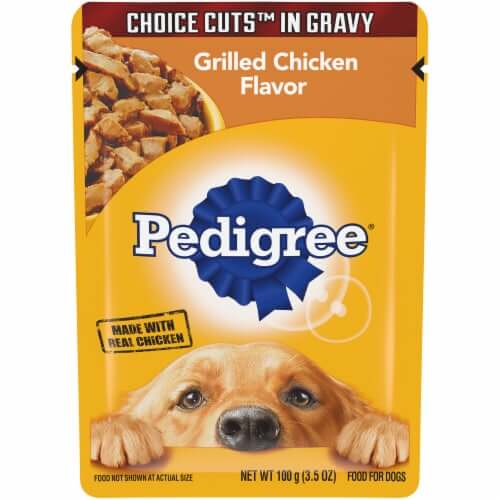
DogFoodAdvisor is reader supported See how
All reviews are 100% impartial but if you buy using links on this page, we may earn a referral fee.
Our Verdict
Pedigree Pouch product range is made up of 15 recipes with ratings varying from 1.5 to 2 stars. The average rating of the whole range is 2 stars.
The table below shows each recipe in this range including our rating and the AAFCO nutrient profile: Growth (puppy), Maintenance (adult), All Life Stages, Supplemental or Unspecified.
| Product line | Rating | AAFCO |
|---|---|---|
| Pedigree Choice Cuts in Gravy Chicken Casserole | 2 | |
| Pedigree Choice Cuts in Gravy Beef, Noodles and Vegetables Flavor | 2 | U |
| Pedigree Choice Cuts in Gravy Grilled Chicken Flavor | 2 | U |
| Pedigree Choice Cuts in Gravy Hickory Smoked Chicken Flavor | 2 | U |
| Pedigree High Protein with Chicken and Beef Cuts in Gravy | 2 | U |
| Pedigree High Protein with Chicken and Turkey Cuts in Gravy | 2 | M |
| Pedigree High Protein Beef and Pork Tenderloin Flavor Cuts in Gravy | 2 | M |
| Pedigree Puppy Morsels in Sauce with Turkey | 2 | U |
| Pedigree Puppy Morsels in Sauce with Beef | 2 | G |
| Pedigree Chopped Ground Dinner Bacon and Filet Mignon Flavor | 1.5 | M |
| Pedigree Chopped Ground Dinner Beef, Bacon and Cheese Flavors | 1.5 | M |
| Pedigree Puppy Morsels in Sauce with Chicken | 2 | G |
| Pedigree Chopped Ground Dinner with Hearty Chicken | 1.5 | M |
| Pedigree Choice Cuts in Gravy Filet Mignon Flavor | 2 | M |
| Pedigree Chopped Ground Dinner with Slow Cooked Beef | 1.5 | U |
Recipe and Label Analysis
Pedigree Choice Cuts in Gravy Grilled Chicken Flavor was selected to represent the other products in the line for detailed recipe and nutrient analysis.
Pedigree Choice Cuts in Gravy Grilled Chicken Flavor
Estimated Dry Matter Nutrient Content
Protein
Fat
CarbsCarbohydrates
Sufficient water for processing, chicken, meat by-products, animal liver, animal plasma, wheat gluten, wheat flour, plain dried beet pulp, corn starch, natural flavor, salt, minerals (potassium chloride, magnesium proteinate, zinc sulfate, copper proteinate, manganese sulfate, copper sulfate, potassium iodide), sodium tripolyphosphate, natural grilled chicken flavor, xanthan gum, guar gum, vitamins (choline chloride, vitamin E supplement, thiamine mononitrate, calcium pantothenate, biotin, riboflavin supplement, vitamin A supplement, vitamin D3 supplement, vitamin B12 supplement), added color
Fiber (estimated dry matter content) = 1.5%
Red denotes any controversial items
| Estimated Nutrient Content | |||
|---|---|---|---|
| Method | Protein | Fat | Carbs |
| Guaranteed Analysis | 8% | 3% | NA |
| Dry Matter Basis | 44% | 17% | 31% |
| Calorie Weighted Basis | 38% | 35% | 27% |
Ingredients Analysis
The first ingredient in this dog food is water, which adds nothing but moisture to this food. Water is a routine finding in most canned dog foods.
The second ingredient is chicken. Chicken is considered “the clean combination of flesh and skin… derived from the parts or whole carcasses of chicken”.1
Chicken is naturally rich in the ten essential amino acids required by a dog to sustain life.
The third ingredient includes meat by-products, an item made from slaughterhouse waste. This is what’s left of slaughtered animals after all the prime striated muscle cuts have been removed.
With the exception of hair, horns, teeth and hooves, this item can include almost any other part of the animal.2
What’s worse, this particular item is anonymous. So, the meat itself can come from any combination of cattle, pigs, sheep or goats — which can make identifying specific food allergies impossible.
Although most meat by-products can be nutritious, we do not consider such vaguely described (generic) ingredients to be as high in quality as those derived from a named animal source.
The fourth ingredient is animal liver. Normally, liver can be considered a quality component. However, in this case, the source of the liver is not identified. For this reason, it’s impossible to judge the quality of this item.
The fifth ingredient is animal plasma. Plasma is what remains of blood after the blood cells themselves have been removed. In most cases, plasma can be considered a nutritious addition.
However, since there’s no mention of a specific animal in the name of this particular ingredient, this item could be sourced from any species. And that fact can make it difficult to isolate the cause of a dog’s food-based allergy.
For this reason, we do not consider generic animal plasma to be a quality addition.
The sixth ingredient is wheat gluten. Gluten is the rubbery residue remaining once wheat has had most of its starchy carbohydrate washed out of it.
Although wheat gluten contains 80% protein, this ingredient would be expected to have a lower biological value than meat.
And less costly plant-based products like this can notably boost the total protein reported on the label – a factor that must be considered when judging the actual meat content of this dog food.
The seventh ingredient is wheat flour, a highly-refined product of wheat milling. Like corn, wheat is an inexpensive and controversial cereal grain of only modest nutritional value to a dog.
For this reason, we do not consider wheat a preferred component in any dog food.
The eighth ingredient is beet pulp. Beet pulp is a controversial ingredient, a high fiber by-product of sugar beet processing.
Some denounce beet pulp as an inexpensive filler while others cite its outstanding intestinal health and blood sugar benefits.
We only call your attention here to the controversy and believe the inclusion of beet pulp in reasonable amounts in most dog foods is entirely acceptable.
The ninth ingredient is corn starch, a starchy powder extracted from the endosperm found at the heart of a kernel of corn. Corn starch is most likely used here to thicken the broth into a gravy.
Corn starch isn’t a true red flag item. Yet we’ve highlighted here for those wishing to avoid corn-based ingredients.
From here, the list goes on to include a number of other items.
But to be realistic, ingredients located this far down the list (other than nutritional supplements) are not likely to affect the overall rating of this Pedigree product.
With two notable exceptions…
First, we’re always disappointed to find artificial coloring in any pet food. That’s because coloring is used to make the product more appealing to humans — not your dog. After all, do you really think your dog cares what color his food is?
And lastly, this food contains chelated minerals, minerals that have been chemically attached to protein. This makes them easier to absorb. Chelated minerals are usually found in better dog foods.
Nutrient Analysis
Based on its ingredients alone, Pedigree in pouches looks like a below-average wet product.
The dashboard displays a dry matter protein reading of 44%, a fat level of 17% and estimated carbohydrates of about 31%.
As a group, the brand features an average protein content of 47% and a mean fat level of 21%. Together, these figures suggest a carbohydrate content of 25% for the overall product line.
And a fat-to-protein ratio of about 47%.
Which means this Pedigree product line contains…
Above-average protein. Below-average fat. And below-average carbs when compared to a typical wet dog food.
Even when you consider the protein-boosting effect of the wheat gluten, this looks like the profile of a wet food containing a notable amount of meat.
Pedigree Dog Food Recall History
The following automated list (if present) includes all dog food recalls related to Pedigree through April 2025.
You can view a complete list of all dog food recalls since 2009 here.
Our Rating of Pedigree Dog Food
Pedigree in pouches is a grain-inclusive moist dog food using a notable amount of named meats and unnamed meat by-products as its dominant source of animal protein, thus earning the brand only 2 stars.
Compare Pedigree Dog Food
How does Pedigree compare with The Dog Food Advisor's most recommended brands?
A Final Word
The Dog Food Advisor does not accept money, gifts, samples or other incentives in exchange for special consideration in preparing our reviews.
However, we do receive a referral fee from online retailers (like Chewy or Amazon) and from sellers of perishable pet food when readers click over to their websites from ours. This helps cover the cost of operation of our free blog. Thanks for your support.
For more information, please visit our Disclaimer and Disclosure page.








